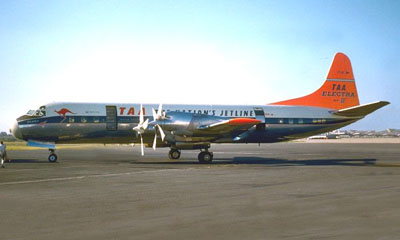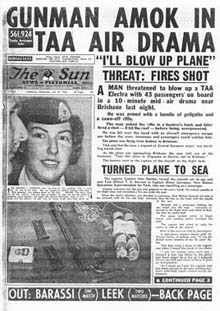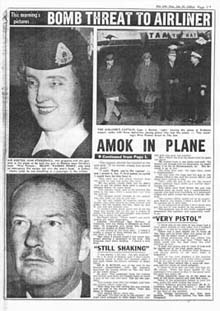
The aircraft VH-TLB 'John Gilbert' in the colour scheme of the day. - 1960
THE TAA SKYJACKING. Worlds First Aircraft Hijacking.
The Trans Australia Airlines hijacking was Australia's, and the first Skyjacking /Hijacking in the world, and it occurred on 19th July 1960. The aircraft, a Lockheed Electra Mk 2 (VH-TLB) was operating Flight 408, the last Sydney to Brisbane flight for the day. Forty three passengers and six crew were on endangered and on board the aircraft.

The crew, Captain John Benton, First Officer Tom Bennett, Flight Engineer Fred McDonald, Hostesses Fay Strugnell and Janeene Christie, were involved in the incident along with a crew member travelling in the cabin, Captain Dennis Lawrence.
The highjacker, Alex Hildebrandt, who was armed with a bomb, a fully loaded sawn-off .22 calibre rifle and had a spare loaded magazine.
He had a suspended bare wire over a torch battery attached to a detonator linked to two sticks of gelignite, and another wire attached from the gelignite to the battery.
Hildebrandt fired a shot to emphasise his intentions when Bennet tried to converse and calm him, and the bullet went through the aircraft ceiling. It narrowly missing First Officer Tom Bennett, but Bennett punched Hildebrandt and pulled the wires from his hand disabling the bomb.
Captain Lawrence then intervened to assist First Officer Bennett to subdue and completely disarm the hijacker, who was restrained and secured with handcuffs carried on the aircraft.
Tom Bennet was awarded the George Medal for his actions and Captain Lawrence was commended for his part in subduing the highjack.
Newspaper Articles

Hildebrandt faced charges of the attempted murder of First Officer Tom Bennett, and of having an explosive detonating device with the intention of destroying the aircraft, and having explosives capable of causing injuries to persons on board.
He was sentenced to three years jail for attempted murder, ten years for attempting to destroy the aircraft and two years for the explosives charge.
He successfully appealed the sentence in the Queensland Criminal Court, argueing that the aircraft which was thirty five minutes into the flight, was over New South Wales when he armed the explosives in the aircraft toilet.
He served a three year sentence in a gaol in Brisbane for attempted murder, and on discharge was immediately arrested by detectives from New South Wales to face court again, and was convicted on the charge of attempted destruction of an aircraft and he spent seven more years in prison in New South Wales.
All crew members were emotionally effected, and were given extended time off before continuing their careers with TAA until they retired or resigned to pursue other careers.